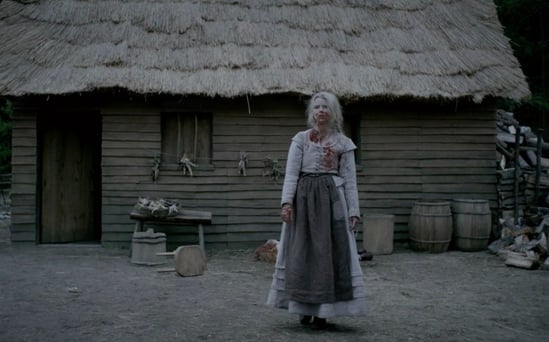Whispers of the Woods: Unearthing the Dark Elegance of The Witch
Cinemapedia
Robert Eggers’ The Witch (2015) is a haunting descent into the shadowy recesses of the human soul, set against the foreboding backdrop of 17th-century New England. With its meticulous attention to historical detail, stark visual design, chilling score, and profound exploration of morality and fear, The Witch stands as one of the most unsettling yet masterfully crafted horror films of the modern era. It is not merely a story about witchcraft—it is a meditation on paranoia, faith, and the fragility of the human psyche.
A Grim and Unforgiving Landscape
From the very first frame, The Witch establishes a world that feels both oppressive and eerily authentic. Cinematographer Jarin Blaschke paints the film in muted, desaturated tones, capturing the bleakness of the wilderness and the isolation of the Puritan family at the story's center. The harsh natural lighting, paired with the use of long, lingering shots, creates an atmosphere of unease that permeates every scene.
The setting itself—the dark, sprawling woods—becomes a character in the film. The dense forest looms like a predator, shrouding secrets and horrors within its depths. The family's small, weathered farmstead, surrounded by barren fields and shadowy trees, mirrors their vulnerability and growing despair. Every detail, from the threadbare costumes to the period-accurate architecture, immerses the audience in a world where survival is tenuous and the supernatural feels disturbingly real.
Eggers’ commitment to authenticity extends to the film’s use of natural elements, such as the flickering glow of candlelight and the stark contrast of shadow and light. These visuals amplify the film’s themes of isolation, fear, and the unknown, making The Witch as much a visual experience as it is a narrative one.
A Slow-Burning Descent into Madness
At its heart, The Witch is the story of a Puritan family exiled from their community and forced to make a life on the edge of an untamed wilderness. Their fragile unity begins to unravel after the mysterious disappearance of their infant son, Samuel. As tensions rise, the family’s eldest daughter, Thomasin (played with mesmerizing intensity by Anya Taylor-Joy), becomes the scapegoat for their misfortunes, accused of witchcraft by her own kin.
The narrative is steeped in historical accuracy, with much of the dialogue drawn from actual 17th-century texts. This attention to detail grounds the film’s supernatural elements in a stark realism, blurring the line between psychological breakdown and genuine witchcraft. Eggers weaves a slow-burning tale of paranoia and mistrust, as the family’s rigid faith turns inward, consuming them in their desperate search for someone to blame.
The film’s ambiguity is one of its greatest strengths. While the presence of a witch is ultimately confirmed, the story leaves room for interpretation, inviting viewers to question whether the true horror lies in the supernatural or in the destructive power of fear and fanaticism.
The Sound of Dread
The score, composed by Mark Korven, is an essential component of The Witch’s oppressive atmosphere. Eschewing traditional melodies, Korven crafts a soundscape of discordant strings, eerie drones, and unsettling choral vocals. The music doesn’t guide the audience’s emotions—it unsettles them, creating a constant sense of dread that mirrors the family’s escalating hysteria.
One of the most striking elements of the score is its use of silence and minimalism. Moments of quiet are punctuated by sudden bursts of jarring sound, keeping viewers on edge and amplifying the film’s tension. The score feels almost alive, a sinister presence lurking just beyond the frame, much like the titular witch herself.
The Consequences of Fear and Isolation
At its core, The Witch is a story about the destructive power of fear and the dangers of blind faith. The family’s rigid adherence to their Puritan beliefs isolates them not only from their community but from one another, turning their faith into a weapon that destroys them from within. Their refusal to confront their own flaws and fears leads to their downfall, as they project their anxieties onto Thomasin, ultimately driving her into the arms of the devil.
The film also explores the theme of liberation through a dark and twisted lens. Thomasin’s eventual embrace of witchcraft can be seen as a rejection of the oppressive structures that have controlled her life. Her transformation is both horrifying and cathartic—a reclamation of agency in a world that has denied her autonomy.
The Witch challenges viewers to confront uncomfortable truths about human nature, faith, and the consequences of isolation. It is a cautionary tale about the perils of fear and the lengths to which people will go to preserve their fragile sense of order in a chaotic world.
A Haunting Masterpiece
The Witch is not a film that relies on jump scares or cheap thrills. Instead, it burrows under your skin with its meticulous craftsmanship, haunting atmosphere, and unrelenting sense of dread. Robert Eggers has created a work of art that lingers in the mind long after the credits roll, a chilling reminder of the darkness that lies within us all.
With its breathtaking visuals, harrowing story, evocative score, and profound moral themes, The Witch is a film that transcends the horror genre, standing as a testament to the power of cinema to disturb, provoke, and enlighten. As Thomasin whispers to the devil in the film’s climactic moments, “Wouldst thou like to live deliciously?” The Witch offers an experience that is as darkly delicious as it is unforgettable.


